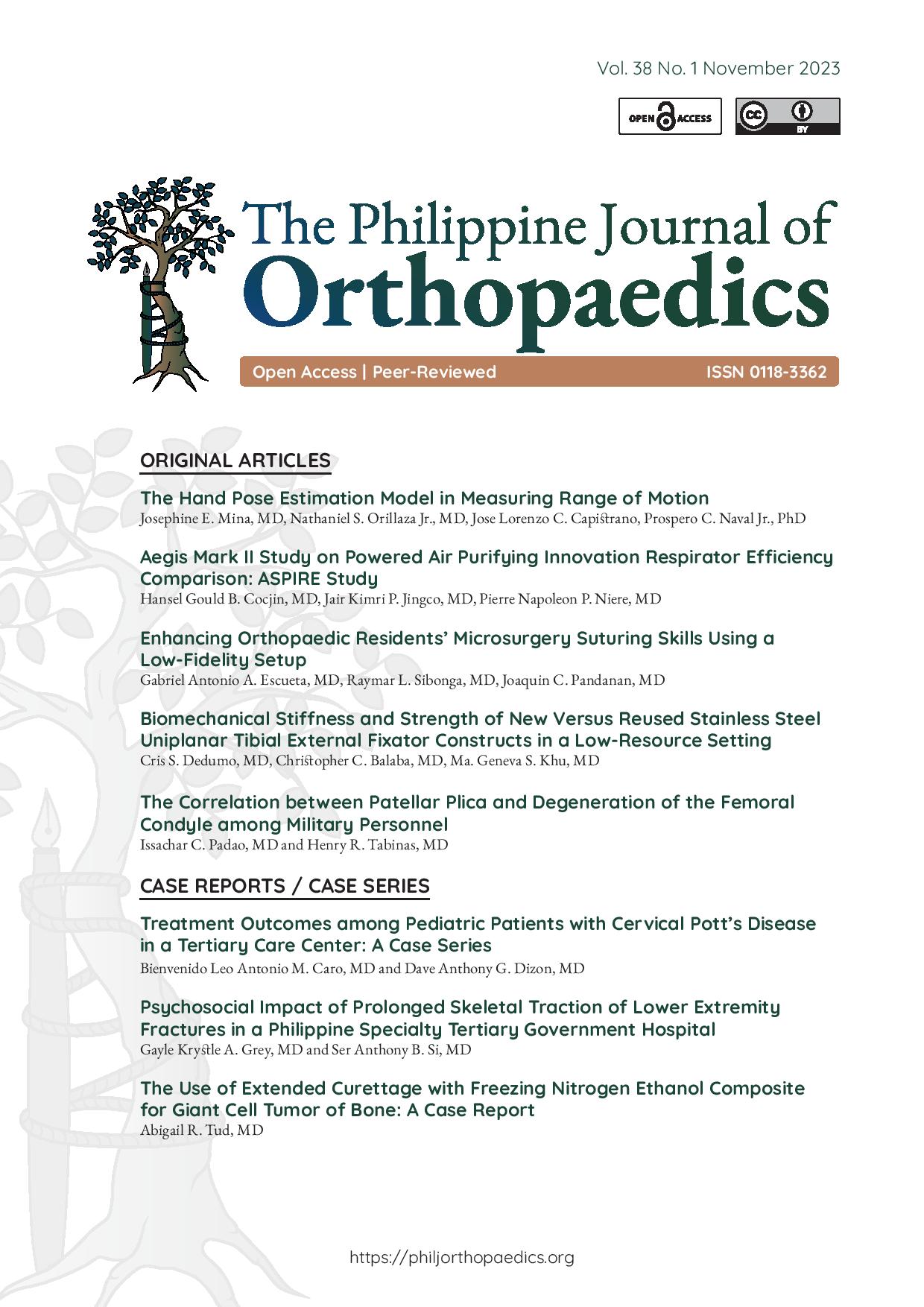Residual Deformity and Outcome in Non-Surgically Treated Tibial Shaft Fractures in Adolescents Nearing Skeletal Maturity A Cross-sectional Study
Main Article Content
Abstract
Background. Anatomic reduction is crucial to avoid malalignment in tibial shaft fractures in adolescents approaching physeal closure. While surgical treatment is becoming more common, casting and immobilization are still widely done for appropriately selected fractures. Local radiographic and clinical outcomes of non-surgical treatment need to be explored.
Objective. The primary objective of this study was to report residual lower limb deformity of tibial shaft fractures treated non-surgically in adolescents nearing skeletal maturity. The study also identified factors or fracture characteristics that may predict these deformities and reported the clinical outcomes using the Lower Extremity Functional Scale (LEFS).
Methodology. This was a cross-sectional study of 31 adolescents nearing skeletal maturity at the time of injury with acute closed tibial shaft fractures treated non-surgically at the Philippine Orthopedic Center from 2017 to 2020. Skeletal maturity and residual sagittal & coronal angulation were analyzed through radiographs. Rotational alignment and leg length discrepancies were evaluated clinically. Functional outcome was measured using the LEFS.
Results. Coronal plane angulation (r = -0.397; p = 0.05) and leg length discrepancy (r = -0.394; p = 0.05) were inversely correlated with LEFS scores. Coronal plane angulation was also correlated with ipsilateral fibular fractures (p = 0.007). LEFS scores were 79.39 on average (range 75 to 80).
Conclusion. Among adolescents nearing skeletal maturity with isolated acute tibial shaft fractures, closed reduction and casting followed by close monitoring remains useful and effective.
Article Details

This work is licensed under a Creative Commons Attribution 4.0 International License.

This work is licensed under a Creative Commons Attribution 4.0 International License.
References
Flynn JM, Waters PM, Skaggs DL, eds. Rockwood and Wilkins’ fractures in children, 8th ed. Wolters Kluwer Health; 2015.
Murphy D, Raza M, Monsell F, Gelfer Y. Modern management of paediatric tibial shaft fractures: an evidence-based update. Eur J Orthop Surg Traumatol. 2021;31(5):901-9. https://pubmed.ncbi.nlm.nih.gov/33978864 https://doi.org/10.1007/s00590-021-02988-0 DOI: https://doi.org/10.1007/s00590-021-02988-0
Hogue GD, Wilkins KE, Kim IS. Management of pediatric tibial shaft fractures. J Am Acad Orthop Surg. 2019;27(20):769-78. https://pubmed.ncbi.nlm.nih.gov/30998564 https://doi.org/10.5435/JAAOS-D-17-00819 DOI: https://doi.org/10.5435/JAAOS-D-17-00819
Stenroos A, Puhakka J, Nietosvaara Y, Kosola J. Treatment of closed tibia shaft fractures in children: a systematic review and meta-analysis. Eur J Pediatr Surg. 2020;30(6):483-9. https://pubmed.ncbi.nlm.nih.gov/31437858 https://doi.org/10.1055/s-0039-1693991 DOI: https://doi.org/10.1055/s-0039-1693991
Kinney MC, Nagle D, Bastrom T, Linn MS, Schwartz AK, Pennock AT. Operative Versus Conservative Management of Displaced Tibial Shaft Fracture in Adolescents. J Pediatr Orthop. 2016 Oct-Nov;36(7):661-6. https://pubmed.ncbi.nlm.nih.gov/27603095 DOI: https://doi.org/10.1097/BPO.0000000000000532
https://doi.org/10.1097/BPO.0000000000000532 DOI: https://doi.org/10.1097/BPO.0000000000000532
Stenroos A, Laaksonen T, Nietosvaara N, Jalkanen J, Nietosvaara Y. One in three of pediatric tibia shaft fractures is currently treated operatively: a 6-year epidemiological study in two University Hospitals in Finland treatment of pediatric tibia shaft fractures. Scand J Surg. 2018;107(3):269-74. https://pubmed.ncbi.nlm.nih.gov/29291697 https://doi.org/10.1177/1457496917748227 DOI: https://doi.org/10.1177/1457496917748227
Kleiner JE, Raducha JE, Cruz AI Jr. Increasing rates of surgical treatment for paediatric tibial shaft fractures: a national database study from between 2000 and 2012. J Child Orthop. 2019;13(2):213-9. https://pubmed.ncbi.nlm.nih.gov/30996747 https://www.ncbi.nlm.nih.gov/pmc/articles/PMC6442513 https://doi.org/10.1302/1863-2548.13.180163 DOI: https://doi.org/10.1302/1863-2548.13.180163
Binkley JM, Stratford PW, Lott SA, Riddle DL. The Lower Extremity Functional Scale (LEFS): scale development, measurement properties, and clinical application. North American Orthopaedic Rehabilitation Research Network. Phys Ther. 1999;79(4):371-83. https://pubmed.ncbi.nlm.nih.gov/10201543 DOI: https://doi.org/10.1037/t35109-000
Leliveld MS, Verhofstad MHJ, Van Lieshout EMM; TRAVEL Study Investigators. Measurement properties of patient-reported outcome measures in patients with a tibial shaft fracture; validation study alongside the multicenter TRAVEL study. Injury. 2021;52(4):1002-10. https://pubmed.ncbi.nlm.nih.gov/33451691 https://doi.org/10.1016/j.injury.2020.12.030 DOI: https://doi.org/10.1016/j.injury.2020.12.030
Cruz AI Jr, Raducha JE, Swarup I, Schachne JM, Fabricant PD. Evidence-based update on the surgical treatment of pediatric tibial shaft fractures. Curr Opin Pediatr. 2019;31(1):92-102. https://pubmed.ncbi.nlm.nih.gov/30461511 https://doi.org/10.1097/MOP.0000000000000704 DOI: https://doi.org/10.1097/MOP.0000000000000704
Zheng W, Chen C, Tao Z, et al. Comparison of the outcomes of pediatric tibial shaft fractures treated by different types of orthopedists: A prospective cohort study. Int J Surg. 2018;51:140-4. https://pubmed.ncbi.nlm.nih.gov/29407250 https://doi.org/10.1016/j.ijsu.2018.01.035 DOI: https://doi.org/10.1016/j.ijsu.2018.01.035
Moran C, Handley B. Clinical guide for trauma and orthopaedic patients during the coronavirus pandemic. World Young Clinicians Network. 2020. Accessed on August 19, 2024. https://www.wyccn.org/uploads/6/5/1/9/65199375/traumaandorthopaedic-clinical-guide-16032020-vboa1.pdf.pdf





